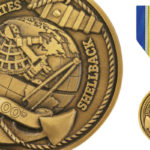Military rank is about more than protocol. Rising through the ranks is about honor and skill. As your display of Army badges and insignia changes, so too does your responsibility for–and to–others.
It is important not to confuse rank with pay grade. For instance, both a specialist and a corporal have the same pay grade, but a corporal is ranked higher because they fill a leadership role that a specialist does not.
U.S. Army insignia serves as a visual signifier of rank and responsibility. There have been changes throughout the long history of the Armed Forces, and it is important to recognize older badges that are no longer in active use. Let’s take a look at how the Army rank insignia has changed over the years.
Initial Army Rank Insignia
When the U.S. Army was formed, and known as the Continental Army, colored epaulets indicated rank. As the uniforms evolved, a variant of the now-familiar chevron badge replaced the epaulets in 1821.
At first, rank dictated the orientation–point-up for staff non-commissioned officers (SNCOs) and point-down for non-commissioned officers (NCOs). Then, in 1847, a new system of enlisted chevrons was introduced, along with horizontal bars and vice arcs, or “rockers,” with the chevrons all worn point-up. But in 1851, the Army changed orientation again, so the point-down direction is what you see on civil war uniforms. Around the turn of the 20th century, the orientation switched back to point-up and has remained that way ever since.

World War I – World War II
During the early 20th century, the massive scale of the battle arena of World War I required a streamlined ranking system to avoid confusion. A War Department leaflet from 1905 laid out the new system, which included chevrons pointing up and introduced designated colors for each branch of the military.
The U.S. Army insignia was simplified in 1920. Buff-on-blue stripes replaced the colored stripes denoting branch-of-service. The complicated structuring of trade badges and rank insignia was abolished, and the rank of specialist was created.
With the attempt to streamline and simplify things, the restructuring led to more confusion. A specialist was placed between a private first class and a corporal in rank, but the difference between a specialist and private first class could not be discerned at first glance, due to the lack of trade badges.
Post commands granted unofficial insignia to specialists to eliminate the confusion. They were allowed to wear one to six arcs under their chevron depending on their specialist class, as well as placing trade badges between their stripes to indicate their specialty.

However, in 1942, the specialist rank was abolished and replaced with technician grades. These included the technician third, fourth and fifth grades, which were equivalent to a staff sergeant, sergeant and corporal, respectively. Technicians were considered superior to all degrees below them, but inferior to the NCOs of the equivalent rank. Their badge was the same as their ranking counterpart except they had a “T” inset between their stripes.

Mid-Century – Present
The technician ranking was even shorter-lived than the specialist ranking. In 1948, that rank was abandoned and technicians were absorbed into the comparable ranking classification. The level of private was subdivided into three ranks: recruit, private second class and private first class.
The buff-on-blue colored insignia was replaced with the unpopular “Goldenlite”, “yellow on green” color setup; the difference between support arms and combat arms was too difficult to tell apart.. Support arms now wore yellow stripes on navy backing, and combat arms wore navy stripes on yellow backing. This new system of arcs and chevrons was smaller and narrower as well.
The Goldenlite insignia proved challenging to interpret at a glance. When the U.S. entered the Korean War, many combat troops abandoned the Goldenlite insignia and returned to the old system. They either purchased the buff-colored insignia from surplus posts or handmade their own.
In 1951, the small Goldenlite insignia was abandoned and replaced with larger olive-drab on navy stripes for servicemen. While the men returned to larger stripes of 3 inches in 1951, the Women’s Army Corps (WAC) was assigned 2-inch yellow-on-brown stripes to wear with their taupe uniforms and female personnel wore 2-inch stripes until 1998.
In 1955, the specialist rank was reactivated, albeit with slightly different rankings. There was now a specialist 3rd class, 2nd class, 1st class and master specialist.
Since the 1950s, there have been relatively few changes to the ranks of Army badges and insignia. The specialist classifications 5-9 have been discontinued so there is now only one specialist rank, which is the most common rank held by Army soldiers. And while the rank of Sergeant Major of the Army was created in 1966, it did not receive its rank insignia until 1979.
The visual organization of Army rank has been relatively steady for several decades. It is unlikely that you will regularly interact with anyone wearing the discontinued insignia. However, the military always honors its past, and it is beneficial to be knowledgeable about former Army badges and insignia.






